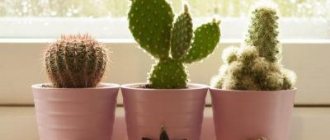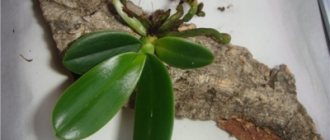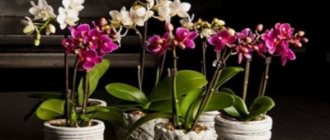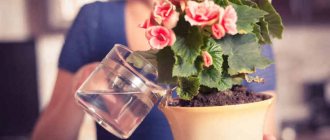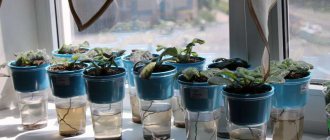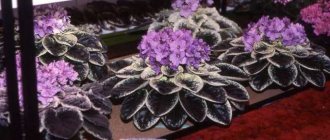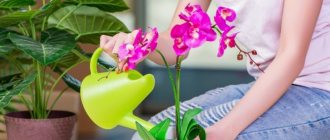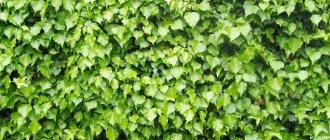Which one is better?
Orchid bark can be purchased at the store or collected yourself. It can only be removed from dead trees, where the presence of resin, harmful insects and pathogenic microorganisms is excluded. In addition, the material peels off freely from the wood surface. The bark of many species is suitable for growing orchids, but experienced gardeners prefer only some of them.
Sosnovaya
Pine bark is considered the best option for planting orchids.
This is due to its availability and several other advantages:
- ease of collection;
- contains phytoncides that prevent infection of the plant by various pests;
- porosity, due to which the material perfectly absorbs moisture;
- sufficient thickness to allow the epiphyte roots to reliably grip.
Oak
Oak is ideal for substrate preparation due to its low acidity and high nutrient content. However, when collecting and preparing it, a number of problems arise:
- high hardness, making processing difficult;
- difficulties in finding a large oak tree, since such trees do not grow in all regions;
- the need for prolonged processing before use.
Florists recommend giving preference to cork oak bark, which has a high degree of moisture absorption.
Other conifers
Pine bark can be easily replaced with spruce bark, since both materials have the same properties. In general, orchids grow well in a substrate containing raw materials taken from any coniferous trees, for example:
- cedar;
- thuja;
- larches, etc.
Why do orchids need bark?
There are three varieties of orchids depending on where they grow:
- epiphytes - grow directly on trees, attaching themselves to the projections of the tree periderm. They feed by obtaining moisture and nutrients directly from the air and precipitation. Epiphytic orchids are found mainly in the tropics. These include: Vanda, Phalaenopsis, Dendrobium. The main difference between epiphytes, as a rule, is the presence of aerial roots devoid of hairs;
- lithophytes are capable of growing on bare rocks. They are considered pioneer plants, as they are the first to populate regions. They create the first layer of soil on which other plants can establish themselves;
- Land plants need fertile soil. They have underground roots. Representatives of Bletilla striata, Pleione, Orchis and Cypripedium.
There are species that can grow in different environments. For example, in soil and on trees, like several varieties of Paphiopedilum: hirsutissimum, villosum and glanduliferum.
The bark is necessary for growing epiphytic orchids. Thanks to her, the roots of exotic beauties have something to gain a foothold on. Orchids receive nutrients from it.
Interesting. Lithophytes and terrestrial varieties do not particularly need bark for growth, but many gardeners add it to the substrate to regulate humidity and as an additional source of nutrients.
Can I use store bought?
Flower growers who do not have the opportunity to independently prepare bark for the substrate can purchase it in the store. The industrial version also needs processing, and has its advantages and disadvantages.
The advantages include the possibility of purchasing raw materials taken from species growing exclusively in southern latitudes: vines, cypress, etc. Among the disadvantages, it is worth noting the uneven fractions and the inability to check the condition of the substrate when purchasing.
In many cases, after opening the packaging, the raw materials are found to have numerous defects: mold, mustiness, the presence of undesirable impurities, etc.
There are a large number of options for ready-made substrates for orchids, among which the most popular are:
- Orchiata – contains radiata pine bark, which has undergone high-quality processing without loss of beneficial properties and nutritional value.
- Seramis + – in addition to bark, it contains clay, complex fertilizers, and a moisture indicator. The composition is quite loose and water-permeable. Recommended for growing large numbers of orchids (for example, in greenhouses).
- EffectBio – prepared on the basis of raw materials from Angara pine. In addition to it, it contains dolomite flour, which lowers the acidity level. The product is thoroughly dried and treated against harmful insects.
- Royal Mix - obtained from calibrated bark that has undergone high-quality heat treatment. In addition to it, the composition includes large peat, coconut fiber, and charcoal. It has a sufficient content of zinc, magnesium and iron.
- Morris Green - made from well-dried and pest-treated bark with large fractions. Allows you to grow orchids both in substrate and on blocks.
Ready mixes
Many companies produce orchid substrate on an industrial scale. Popular:
- Bio effect;
- Complex Seramis;
- Royal Mix;
- Orchiata and others.
A variety of ingredients necessary for epiphytes are added to the mixture: moss, peat, dolomite flour. The compositions are completely ready for planting indoor orchids.
It is not easy to name the best substrate. Each product has its own characteristics, which suit some gardeners and cause dissatisfaction among others. You need to select the mixture yourself. It makes sense for novice gardeners to try several different compositions on different specimens of the same species.
What technology do firms use?
To prepare bark for substrates on an industrial scale, it is removed from trees on woodworking machines. In fact, this is industrial waste, so making mixtures does not harm the environment.
After removing the periderm:
- clean contaminants: sand, dust with a jet of air;
- the raw materials are washed and heated several times using special equipment;
- disinfect;
- crushed to the desired size;
- sent for the production of the finished substrate.
Washing with special equipment makes it possible to completely remove resins and tannins that can harm exotic beauties.
On a note. Because the bark is removed from a fresh tree, there may be fiber residue left behind. This does not affect the quality of the substrate.
DIY preparation
Independent preparation for the substrate requires compliance with several rules and is carried out in stages.
Tools
For collection and subsequent processing, you need pruning shears and a large cooking container.
Collection
Harvesting can be done in places where suitable trees grow: in parks, forest parks, forested areas, or you can ask at a sawmill.
Basic recommendations:
- Use only sawed, fallen or dead trees that have already dried out. This is due to the absence of resin, pests, bacteria and fungi on them.
- Choose only those raw materials that do not have growths, dust and stains.
- It should peel off easily from the wood surface, and its thickness should be at least 1 cm.
- Carry out the preparation in dry and sunny weather.
- Collecting material from rotten trees is unacceptable.
Resin cleaning
Before the processing procedure, the bark is inspected for the presence of frozen resin. Detected fragments are rejected. Flower growers also recommend cleaning the top gray layer with a metal sponge, which may also contain resin residues.
Grinding
Using pruning shears, cut the bark into pieces of equal size.
The optimal fraction size for small orchids is from 1 cm to 1.5 cm, for large epiphytes – from 2.5 cm to 3 cm.
Tiny fragments can be used for planting baby orchids, as well as for preparing substrates with a complex composition.
Do I need to wash or soak?
It is not necessary to wash the bark. It is best to use a galvanized bucket for soaking. Algorithm of actions:
- Carefully place the bark fractions in a container and press down with a heavy object to prevent them from floating.
- Pour a solution of any insecticide, leaving 5 cm sides.
How to cook?
The process includes several stages:
- Place the container with the soaked bark on low heat.
- Place a lid with a weight on top so that the substrate does not float up.
- Boil for 1-1.5 hours. Large pieces are cooked for about 2-3 hours.
- Remove the container from the heat and set aside to allow the water to cool.
- Drain the cold liquid.
- Drain the bark in a colander.
- Wait until the remaining liquid drains.
This will get rid of possible pathogenic organisms and pests. Also, during this time, the structure of the raw material will be cleared of various contaminants, and in the future it will pass water well.
If the soaking process is skipped, then cooking must be carried out three times in ordinary tap water, each time draining the old water and pouring in new water.
Drying
Drying is recommended exclusively in fresh air. In clear weather, the raw materials are laid out in a thin layer in direct sunlight, in damp weather - under a canopy. On average, the duration of this procedure is about one month. To check the readiness of the raw materials, one fraction is broken into two parts - it must be dry inside.
In order to speed up the preparation process, the drying time can be reduced to one week. But after this, calcination in the oven should be carried out for at least 1-2 hours.
Calcination in the oven
Processing in the oven completely replaces cooking. The process includes several manipulations:
- Place the raw materials in an oven preheated to 75-80 °C.
- Heat for 20 minutes.
- Remove material and store.
How to choose material
Bark is a general term denoting a complex of tissues of various structures and origins covering the cambium of stems and roots. To plant orchid plants, you can use bark from large types of wood; the raw material can be used in its pure form or a mixture can be prepared based on it. Tree bark not only structures the substrate, it retains moisture and nourishes the plant with all the elements necessary for normal development and abundant flowering.
Attention! Flower growers use 2 types of material - small fractions as mulch, and from large fragments they make blocks on which epiphytes can grow without flowerpots.
Raw materials can be found in plantings, forests, city park areas, and sometimes on your own plot; those who have old conifers growing nearby are especially lucky. It is best to harvest the upper layers of bark that have peeled off from the trunk; they break more easily and contain a minimal amount of resin. It is undesirable to collect sun-bleached, rotten, insect-eaten and darkened areas.
During the harvesting process, you need to ensure that there are no bast fibers on the separated fragments; they cannot be used when planting orchid plants due to their rigid structure. Small fragments of wood can become embedded in the root, leading to rot. The collected raw materials must be cleaned of insects, dirt and loose layers. The bark of which tree species is more suitable for orchids is described in the table.
| Wood species | Peculiarities |
| Pine and spruce | Common substrate material. Due to the rapid decomposition of raw materials, the preparation process is simplified |
| Hardwood and softwood | Suitable for phalaenopsis orchids, but there are not many trees with peeling bark (without phloem fibers) |
| Cedar, cypress and thuja | It is acceptable to use for making a substrate, but only if there are no other options, since the decomposition process is very long |
When collecting material, you need to carefully assess the condition of the tree; it should not be rotten or have obvious signs of disease. The collected material will crumble easily and can also become a source of infections and harmful insects that are dangerous for the orchid. It is permissible to take raw materials from a fallen or dry tree. Over time, nutrients accumulate in the fibers, and there is practically no resin left in them. Residents of the European part can use oak bark to plant orchids; it is more nutritious than pine.
Use for growing and transplanting
Large fractions are used as an independent substrate and for growing large orchids. Small pieces are well suited for preparing complex compositions and planting baby plants.
As part of potting soil
First, lay pieces of foam or expanded clay on the bottom of the pot in a layer of 3-4 cm. Then wood bark, the first 2-3 layers of which should consist of large fractions. After this, the roots of the epiphyte are lowered into the container. They should fit freely and be above the lower layers.
Next, holding the plant suspended, small pieces are poured into the pot, placing them between the roots.
The bark should be poured only up to the root collar, since its overlap is unacceptable.
In addition to the bark, you can add the following components in equal parts to the container:
- sphagnum moss;
- charcoal;
- peat.
A substrate with this composition allows air to pass through well and retains moisture after watering.
Read more about what should be included in the substrate and how to prepare it yourself here.
Landing on the block
In some cases, an orchid is planted not in a substrate, but in a block constructed from bulky pieces of bark. A small amount of sphagnum is laid on the block, and the epiphyte is pressed on top. A fishing line or wire with low rigidity and thickness is used as a fixing device.
As an independent substrate
The procedure consists of several stages:
- Soak the bark for 2-3 days to ensure it retains moisture.
- Remove from water and dry for ½ day.
- Cut if necessary.
- Place a layer of drainage on the bottom of the container and large fractions of bark on top.
- Next, place the orchid roots and carefully straighten them.
- Place small pieces of raw materials, periodically tapping the container.

